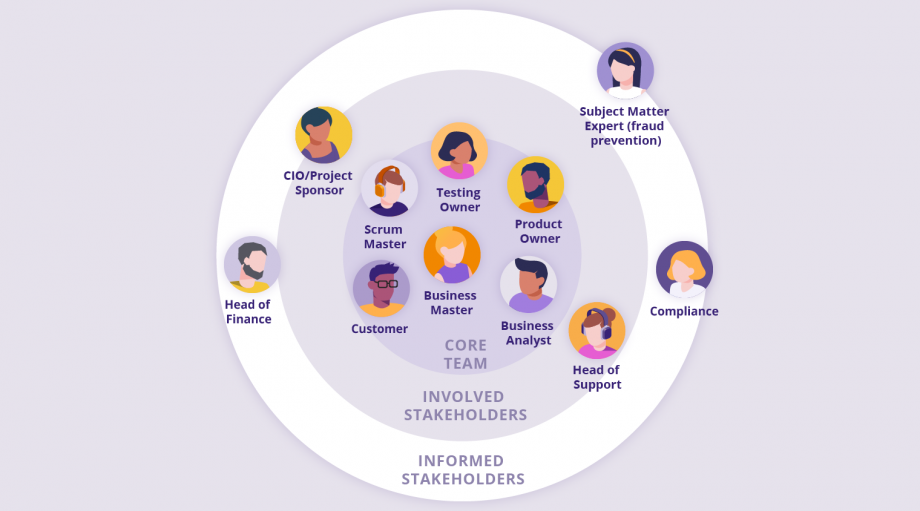The secrets to building a stakeholder map

Creating a Connected Experience is a journey that involves many stakeholders. Identifying and efficiently communicating with them early on will drastically improve your project’s odds of success. In this article, we’ll reveal the secrets to stakeholder mapping and how to make it work for delivering business outcomes.
Why does your initiative need a stakeholder map?
Stakeholder mapping is a technique for visually illustrating the key stakeholders in a project and how they relate to each other. It’s an easy way to get a birds-eye view of the various talents involved in an initiative, how they sync together, and how to keep them engaged so they can positively influence the outcome of your projects. A stakeholder map can be particularly useful for planning and executing change initiatives. For example, it can be used to help you identify those individuals or groups who control critical resources responsible for your success, as well as those who may have an interest in seeing your initiative fizzle.
What makes a stakeholder map useful? Creating a stakeholder map makes it easier to give opportunities to people who have a direct stake in the project, empowering them to participate and influence the outcome.
The map will reflect changes in the project and prioritize actions by looking at relationships from the customer’s perspective (the users that benefit most from the project) while consulting with the key stakeholders who have an important stake in those changes.
A map will easily allow engaging key stakeholders early, together with gathering essential information, to get your initiative started. It will also help you anticipate their questions and requirements, as well as enable you to secure the resources needed to kickstart the project.
Lastly, using stakeholder maps will help your communication efforts by ensuring everyone is on the same page with the goals and milestones that your team are working towards. This is also a great way to ensure visibility across all stakeholders.
How to get started with stakeholder maps
Here are the five steps to take when you start building your stakeholder maps:
Step one: Starting from the customer outcome you’re setting out to deliver, identify all individuals (say on your whiteboard) and personalize it with name, titles, and their roles.
Step two: Group them based on the voices they represent. Display the overlaps and gaps on your whiteboard. Identify relevant individuals that are missing and add them to the whiteboard.
Step three: You can make the relationships visible by drawing lines between groups and note any pertinent details such as the workflow between them, any communication challenges.
Step four: Prioritize the relationships you need. Score their importance by thinking from the customer’s perspective, not your own organizational hierarchy. Based on this, decide who should be informed and involved regularly and who just needs to be kept updated from time to time.
Step five: The team should refer to the map and add new individuals when needed from new learnings.
As mentioned earlier, a good starting point for creating your map is to build a list of stakeholders with a direct stake in the outcome of your project. Consider that there are two types of stakeholders: internal and external to your project.
Internal project stakeholders are the people in your company who will be directly contributing to and affected by the outcome of your project—your Core CE Team (e.g., Business Owner, Product Owner, Scrum Master, Engineer, Designer). It’s essential to look at key influencers as they are the colleagues who could tip the scales in your decision-making process—these can be Involved Stakeholders from the C-Level suite or people from your Core CE Team with decision-making power, such as the CX Leads.
The external project stakeholders can include SMEs that are not part of your organization, customers, and partners.
Once you’ve mapped people and resources, you should consider overlays of key people and ideas. We’ll be covering an example of a stakeholder map in our next article, so read on for practical advice on how it should look like.
Pro tips for building the perfect stakeholder map
1. Not all stakeholders are created equal—prioritize your stakeholders and engage with them based on their level of importance from the customer outcome. For example, if you’re enabling self-service for an insurance claims process, the frontline filing agent might be prioritized over a product advertising manager.
2. Think about their hopes and fears—create user personas for your stakeholders with details beyond the job title: What are their big goals? What motivates them to succeed? What worries them? Adding these to your map will create a clear picture of why these people are your stakeholders and what they care about most.
3. Highlight strong relationships—any connections between stakeholders that can have an impact on their point of view. Any dependencies or contentions between them should be noted on the map with symbols that can represent the relationships at play.
4. Be inclusive—the stakeholder map should be as detailed as possible to understand deeper complexities. As your work will affect your team, your business, as well as your customers, it’s essential to connect the individuals and groups so that it’s easier to zoom in and out when you need to.
5. Take different perspectives into account—Once you’ve built your stakeholder map, analyze it by taking different perspectives into account. Look at the customer’s experience from their point of view. Test out different lenses as you analyze the stakeholders and the relationships that will help you identify who’s missing or which group is overrepresented. It will also help you communicate better with each group.
6. Constantly update your stakeholder map—keep checking your map and update it on a regular basis as your project progresses. Important triggers to revisit the map can come from customer feedback and new learnings discovered along the design process.
Thinking you don’t have everything figured out and planned? The goal is to really understand the connections on your map. Your stakeholders’ personas might change, but that’s part of the process, so keep redrawing but always looking towards the North Star—the problem you set out to solve.
